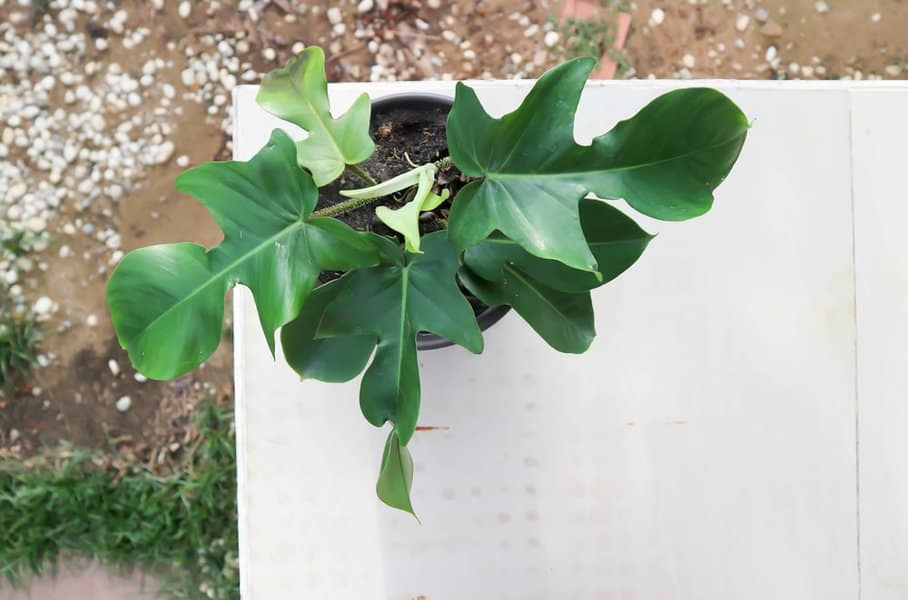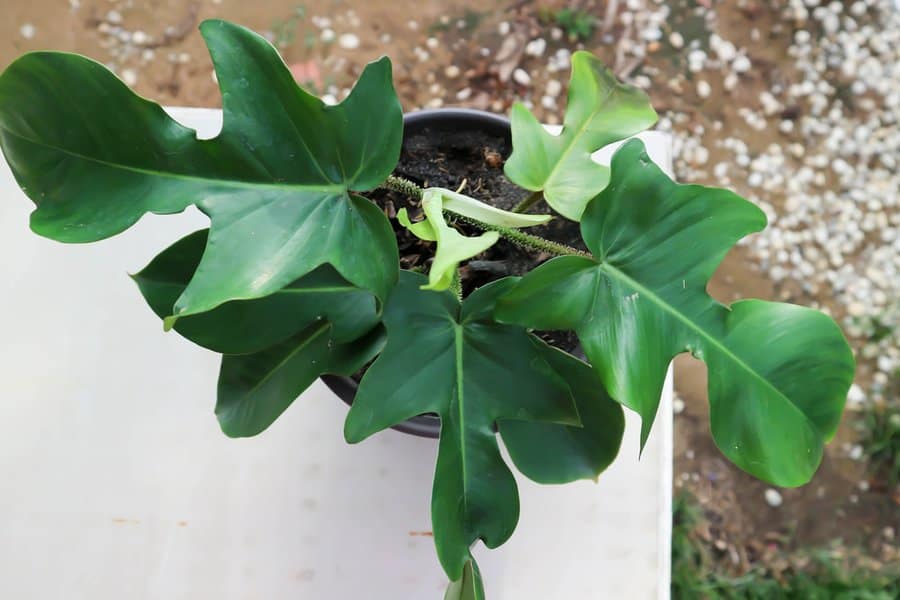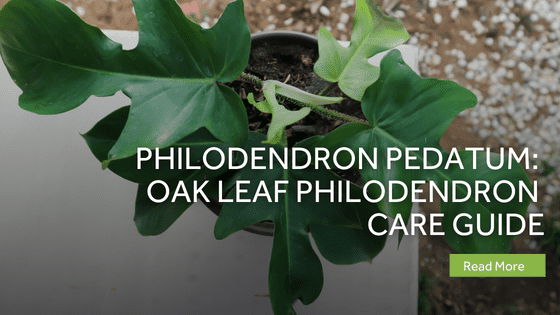If you’re looking for a statement plant, the Philodendron pedatum is it. The large, green leaves speak volumes, and the plant even purifies the air around it. It’s a low-maintenance plant that is great even for beginners and makes a wonderful gift.
Table of Contents
Philodendron Pedatum Overview
The Philodendron pedatum has abstract leaves and is native to Brazil and Venezuela. While it seems like it should be a tropical plant, the oak leaf philodendron also works well as an indoor plant.
The Philodendron pedatum is from the Araceae family and the Philodendron genus. Throughout its time, it’s had many names and has even had botanists confused. It has a few names, but its universal name is Philodendron pedatum.
Other names include oak leaf philodendron, caladium, and dracontium laciniatum. The plant’s leaves have different stages and look different in each stage.
Most philodendron plants look similar and are often confused for one another. The most commonly confused variety of the philodendron plant is the Philodendron Florida plant. The pedatum plant is the parent of the Florida plant, which is why they have many similarities. The Florida beauty, however, is a more compact climber than the pedatum plant.
| Origin | Venezuela and Brazil |
| Family | Araceae |
| Genus | Philodendron |
| Sunlight | Indirect light |
| Watering | Weekly |
| Soil | Well-draining |
| Temperature | 60 – 80 degrees Fahrenheit |
| Propagation | Stem cuttings |
| Re-Potting | When the roots outgrow the pot |
| Pests and Diseases | spider mites, scale insects, and mealy bugs |
| Toxicity | Toxic to humans and pets |
Related Article: Philodendron Mamei: Silver Cloud Ultimate Care Guide
Philodendron Pedatum Features
Like most plants you can grow indoors and out, the plant’s growing conditions determine its height. However, they typically grow from 39 inches to 118 inches tall. The leaves, which have multiple lobes, grow to six to eight inches long, but in perfect conditions, they can get up to 14 inches long.
In its juvenile state, this plant is often confused for other philodendron plants, but in maturity, there’s no denying the type of plant because its leaves are so unique. In young plants, the leaves are oblong and dark green. As the leaves mature, they take on the five-point structure mature leaves are known for.
Like most philodendron plants, this plant is a climbing aroid houseplant, and if you keep it indoors, it will need a moss pole to climb.
Like most tropical plants, this plant can flower but rarely does. If you’re lucky enough to see it flower, they are usually brown or brownish green.
The plant is toxic to kids and pets, so keep it out of reach and contact a medical professional immediately if ingested.

How Do You Care for a Philodendron Pedatum?
Philodendron pedatum care is simple, making it a great plant for beginners or to give as a gift. You don’t necessarily need a ‘green thumb’ to enjoy this plant’s beauty.
Ideal Growing Place
You can grow the oak leaf philodendron indoors or outdoors. Outdoors, though, it only survives in warm temperatures, so don’t plant it in the ground if the temperature in your area gets cold.
Indoors, it does well in pots and hanging baskets, but since it’s a climber, make sure you give it ample space to grow.
Water
Water your Philodendron plant weekly in the warmer months, and don’t overwater it. Ideally, the first two inches of soil should dry before watering it. You can tell by sticking your finger in the soil and determining its moisture level.
You can go 10 – 14 days without watering in the cooler months. If you notice the leaves turning yellow, it’s usually a sign that you’re overwatering and should cut back.
Like most plants, overwatering can lead to root rot, which can kill your plant, so stick to less frequent watering, or if it makes you feel better, water frequently, but in smaller amounts.
Sunlight
This aroid plant loves the sun but bright indirect light. Direct sunlight can cause the leaves to burn, so avoid direct sunlight. If you plant it outdoors, plant it near a tree or something else that will filter the sunlight, so it’s not too direct.
Ideally, the plant will get six to ten hours of filtered sunlight. Indoors, you can filter the light with drapes or keep it near a south-facing window, keeping the plant approximately five feet away from it.
Temperature
Like most Philodendron plants, the pedatum philodendron doesn’t like cold weather. The lowest temperature it should be outside in is 60 degrees. If you keep your plant indoors, it’s important to keep it away from drafty windows, such as single pane windows that don’t keep the cold drafts out and away from your plant.
Also, avoid keeping the plant too close to the furnace or vents. The dry air is detrimental to the leaves.
Ideally, your plant should be within a shot of bright indirect light and indoors during the colder months.
Soil
The pedatum philodendron does well with potting soil mixed with peat moss and pumice. However, the soil must be well draining and drain fast. It should also allow proper airflow while retaining moisture.
Avoid potting mix that includes sand or bark, as it’s not good for the plant’s roots. You could even go without potting soil and use peat and sphagnum moss in equal parts to avoid soggy soil.
You want the pH of the soil to remain between 5.5 and 7.0, which is slightly acidic to neutral. If you are unsure about the pH of your soil, you can pick up a soil testing kit.
Humidity
Like most tropical plants, this plant loves humidity. If you can keep humidity levels above 60%, the plant will thrive the most. This keeps the plant moisturized and the leaves looking their best.
However, this hearty plant does well in drier conditions too. An easy way to fix the humidity issues is to add a pebble tray with water underneath the plant. You can also spray the leaves lightly with purified water to keep the leaves moisturized.
Related Article: Syngonium Erythrophyllum – Guide to Growing a Gorgeous Arrowhead Plant
Fertilizer
The Philodendron pedatum grows fast and therefore needs fertilizer often. Opt for organic fertilizers versus concentrated chemicals, though. You can use a store-bought fertilizer, just make sure it’s rich in nitrogen and look for time-release fertilizers for best results.
If you want to make your own fertilizer, you can use old coffee grounds sprinkled directly over the soil. You could also use aquarium water if you have fish at home.
Only fertilize in the spring and summer months, and hold off in the fall and winter. The plant doesn’t grow in the winter, so fertilizing it won’t help.
Pinching/Pruning
Typically, this plant doesn’t require much pruning. It’s a fast-growing plant but loves its original pot and doesn’t need re-potting often.
Pruning is only required when you notice leaves with brown tips or yellow spots. These leaves aren’t healthy and should be removed to ensure you have an overall healthy plant.
Potting and Re-potting
You can leave this plant in its original pot until you see the roots poking out of the drainage holes. Once this happens, remove the plant and excess soil from its pot.
When choosing the new pot, make sure it measures three to five inches wide but is at least three inches deeper than the original pot.
After re-potting, don’t fertilize for at least two weeks. This makes the roots transition much less stressful for the plant.
Growth Zone
The oak leaf philodendron does best in zones 9 – 11. However, if you grow it outdoors in any other zone, bring it inside before the temperatures get below 60 degrees and definitely before there is any frost.
Common Pests, Toxins, Diseases & Other Problems
Like most plants, the philodendron pedatum has its share of pests and diseases it faces.
The most common pests are spider mites, scale insects, and mealy bugs. You’ll know if you have spider mites, if the leaves have brown or yellow spots, or you see spider webs. To get rid of spider mites, carefully rinse the plant with water. If that doesn’t work, rub the leaves with neem oil.
Scale insects are harder to get rid of because they attach to the plant and look like little bumps instead of bugs. Using neem oil, you can carefully remove the bugs, but be careful not to hurt its leaves.
Mealybugs appear as white puffs on the leaves and are removed by rubbing a cotton ball with isopropyl alcohol and cleaning the leaves with it.
The most common disease the oak leaf philodendron is prone to is root rot. This often happens with overwatering or not potting the plant in a well-draining pot.
Propagation
There are two ways to propagate the Philodendron pedatum.
Stem Cuttings
Cut a stem with recent growth and at least one leaf node using sterilized scissors. Immediately plant the stem cutting in organic soil. Place it in bright indirect light and spray the soil often to ensure it remains moist.
To propagate in water, take a stem cutting, and instead of putting it in soil, put it in water. Make sure the bottom three to five inches of the stem is in the water, including the leaf node. Change the water at least weekly and once you see roots grow, transfer the cutting to the soil.
Related Article: Philodendron Sodiroi: Care Guide to Growing Rare Silver Leaf Philos
Seeds
Propagating by seeds will be slower than using stem cuttings. It takes about 5 to 7 months to get a little plant to grow.
To grow the seeds, plant them 1/3 inches into the soil with the requirements above. You can spray the soil to avoid moisture loss. Place the pot in indirect light, making sure it is warm. You should see seedlings sprouting anywhere from 2 to 8 weeks.
After they have sprouted, you can transfer them into individual pots for even growth.
Philodendron Pedatum Mature Timeline
Planting the stem cuttings in water, it will take seven to eight weeks for the roots to grow and the plant to be ready to live in the soil. However, if you plant the stem cutting in soil immediately, the growth rate can shorten to five to six weeks to see shoots growing.

Philodendron Pedatum FAQ
When Should I Fertilize My Philodendron?
Only fertilize your philodendron in the growing season or in spring and summer. It should only need fertilizer monthly, but if you have a fast-growing plant, you may need to fertilize it more often.
Avoid fertilizing in the fall and winter as the plant doesn’t grow during those months, and fertilizer could hurt it.
How Old Does Philodendron Pedatum Have to Be Before They Bloom?
It’s rare for the Philodendron pedatum to bloom flowers. If it does, it’s in the growing season and not until the plant is a couple of years old.
Is Philodendron Pedatum a Fast Grower?
Yes, this Philodendron plant grows very fast and is easy to take care of for most people.
Where Can I Buy Philodendron Pedatum?
You can find Philodendron plants at most nurseries, including big box stores. You may find your best prices at online nurseries or Etsy, though.
What Is The Difference Between Philodendron Pedatum vs Florida Ghost vs Glad Hands vs Bipennifolium?
The main difference between the Pedatum and the Florida Ghost plant is the color of the petioles. The Pedatum plant has smooth green petioles, but the Florida plant has dark red petioles, and its leaves are rougher.
The glad hands plant has dark green leaves that resemble hands. However, the leaves are much narrower than the Pedatum.
Finally, the Bipennifolium has yellow leaves in its juvenile state and green leaves as they mature. The leaves of this plant are narrow too.
Is the Philodendron Laciniatum The Same As Philodendron Pedatum?
Philodendron laciniatum is a nickname for the Pedatum plant. They are the same plant.
How Long Do Philodendron Pedatum Blooms Last?
The Philodendron plant doesn’t flower often; if it does, they only last through the spring and early summer months.
What Kind of Pot Is Suitable for a Philodendron Pedatum?
Your Philodendron plant can survive in its original pot for several years. Once the roots grow out of the drainage holes, it’s time to re-pot it, but they don’t need to live in a certain type of pot.
Is Philodendron Pedatum Rare?
You can find the Philodendron plant at most stores. It’s not rare and great for anyone looking to add to their plant collection.
Is Philodendron Pedatum Toxic to Pets and Humans?
The oak leaf philodendron is very toxic to humans and pets. Keep it out of reach of children and seek medical attention if ingested.
Philo Pedatum – The Bottom Line
If you’re looking for a beautiful plant with unique leaves to add to your collection, the Philodendron pedatum is a great option. It propagates well, making it easy to give as gifts, and it grows well indoors and out.
Last Updated on October 5, 2022 by Gustaf Johansson




